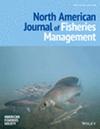Improving electronic reporting rates in the U.S. recreational fishery for Atlantic Bluefin Tuna
IF 1.4
4区 农林科学
Q3 FISHERIES
引用次数: 0
Abstract
In recent years, electronic self‐reporting has emerged as a potentially powerful tool for timely collection of catch and effort data from recreational fisheries. Such approaches are particularly critical given that recreational fisheries contribute significantly to fishing mortality for popular marine fish species in North America and elsewhere. However, many self‐reporting programs are voluntary and struggle with angler recruitment and retention, while those that are mandatory have demonstrated mixed success with angler compliance. In this study, we surveyed Massachusetts anglers in the recreational fishery for Atlantic Bluefin Tuna Thunnus thynnus; anglers in this fishery are required to report all landings and dead discards, but compliance has historically been poor.The survey assessed respondents' Bluefin Tuna fishing experience and behavior, opinions about self‐reporting, and views on the effectiveness of various strategies to increase self‐reporting rates. Because we had access to past reporting history, we were able to compare responses between those who had previously reported Bluefin Tuna and those who had not.We achieved a response rate of 21.9%, and by comparing survey responses with past reporting history, we estimated a reporting compliance rate of only about 42%. Surprisingly, responses to survey questions generally did not differ markedly between reporters and nonreporters, although we did find evidence that those who complied with the self‐reporting requirement had less faith in the Bluefin Tuna fishery's management process. Among the top strategies identified by respondents to increase reporting compliance were (1) providing incentives; (2) providing behavioral “nudges,” such as reminders; (3) better educating anglers on the benefits of self‐reporting; (4) increasing the user‐friendliness of the reporting technology; and (5) the reframing of norms through leveraging leaders in the fishery.Our findings can help to inform self‐reporting and other citizen science approaches to maximize the quantity and quality of recreational data collected, in turn informing the sustainable management of this sector.提高美国休闲渔业大西洋蓝鳍金枪鱼的电子报告率
近年来,电子自我报告已经成为一种潜在的强大工具,可以及时收集休闲渔业的渔获量和努力量数据。鉴于休闲渔业对北美和其他地方流行的海洋鱼类的捕捞死亡率有重大影响,这种办法尤其重要。然而,许多自我报告项目都是自愿的,并与垂钓者的招募和保留作斗争,而那些强制性的项目在垂钓者的遵守方面取得了不同程度的成功。在这项研究中,我们调查了马萨诸塞州休闲渔业中大西洋蓝鳍金枪鱼的垂钓者;该渔场的垂钓者被要求报告所有上岸的鱼和丢弃的死鱼,但遵守情况一直很差。该调查评估了受访者的蓝鳍金枪鱼捕捞经验和行为,对自我报告的看法,以及对提高自我报告率的各种策略的有效性的看法。因为我们可以访问过去的报告历史,我们可以比较那些以前报告过蓝鳍金枪鱼和没有报告过蓝鳍金枪鱼的人的反应。我们获得了21.9%的回复率,并且通过将调查结果与过去的报告历史进行比较,我们估计报告的遵从率只有42%左右。令人惊讶的是,调查问题的回答在记者和非记者之间普遍没有明显差异,尽管我们确实发现证据表明,那些遵守自我报告要求的人对蓝鳍金枪鱼渔业的管理过程缺乏信心。受访者确定的提高报告合规性的主要策略包括:(1)提供激励;(2)提供行为性的“轻推”,如提醒;(3)更好地教育垂钓者自我报告的好处;(4)提高报告技术的用户友好性;(5)通过撬动渔业领导者来重新构建规范。我们的研究结果有助于为自我报告和其他公民科学方法提供信息,以最大限度地提高所收集的娱乐数据的数量和质量,从而为该部门的可持续管理提供信息。
本文章由计算机程序翻译,如有差异,请以英文原文为准。
求助全文
约1分钟内获得全文
求助全文
来源期刊
CiteScore
2.60
自引率
18.20%
发文量
118
审稿时长
2 months
期刊介绍:
The North American Journal of Fisheries Management promotes communication among fishery managers with an emphasis on North America, and addresses the maintenance, enhancement, and allocation of fisheries resources. It chronicles the development of practical monitoring and management programs for finfish and exploitable shellfish in marine and freshwater environments.
Contributions relate to the management of fish populations, habitats, and users to protect and enhance fish and fishery resources for societal benefits. Case histories of successes, failures, and effects of fisheries programs help convey practical management experience to others.

 求助内容:
求助内容: 应助结果提醒方式:
应助结果提醒方式:


